Developing Leadership and Management Skills Report Analysis
VerifiedAdded on 2023/01/12
|13
|4364
|90
Report
AI Summary
This report provides a detailed analysis of leadership and management, exploring their definitions, roles, and responsibilities within an organizational context. It differentiates between leadership and management, highlighting their similarities and differences, and emphasizes their combined importance for achieving organizational success. The report delves into the qualities and skills of successful leaders, examining individuals like Bill and Melinda Gates, Satya Nadella, and Greta Thunberg, and analyzing the factors contributing to their achievements. Furthermore, the report discusses various leadership styles, including Laissez-Faire and democratic approaches, and their impact on organizational performance. The content covers the core functions of managers and leaders and provides insights into how both elements contribute to sustainable business growth and effective resource utilization. The report also stresses the significance of a leader's ability to inspire and motivate individuals and teams to reach organizational goals. This assignment is contributed by a student to be published on the website Desklib. Desklib is a platform which provides all the necessary AI based study tools for students.
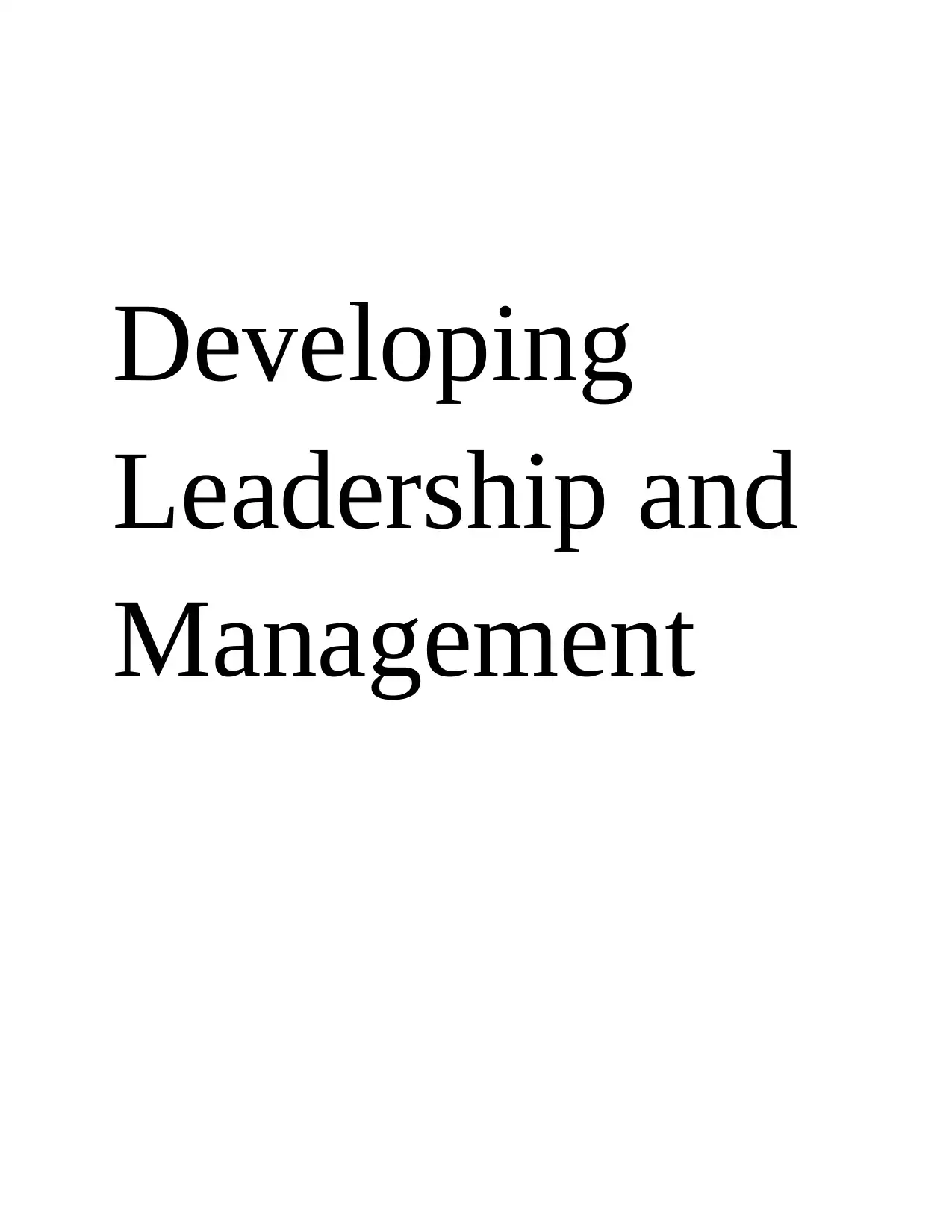
Developing
Leadership and
Management
Leadership and
Management
Secure Best Marks with AI Grader
Need help grading? Try our AI Grader for instant feedback on your assignments.
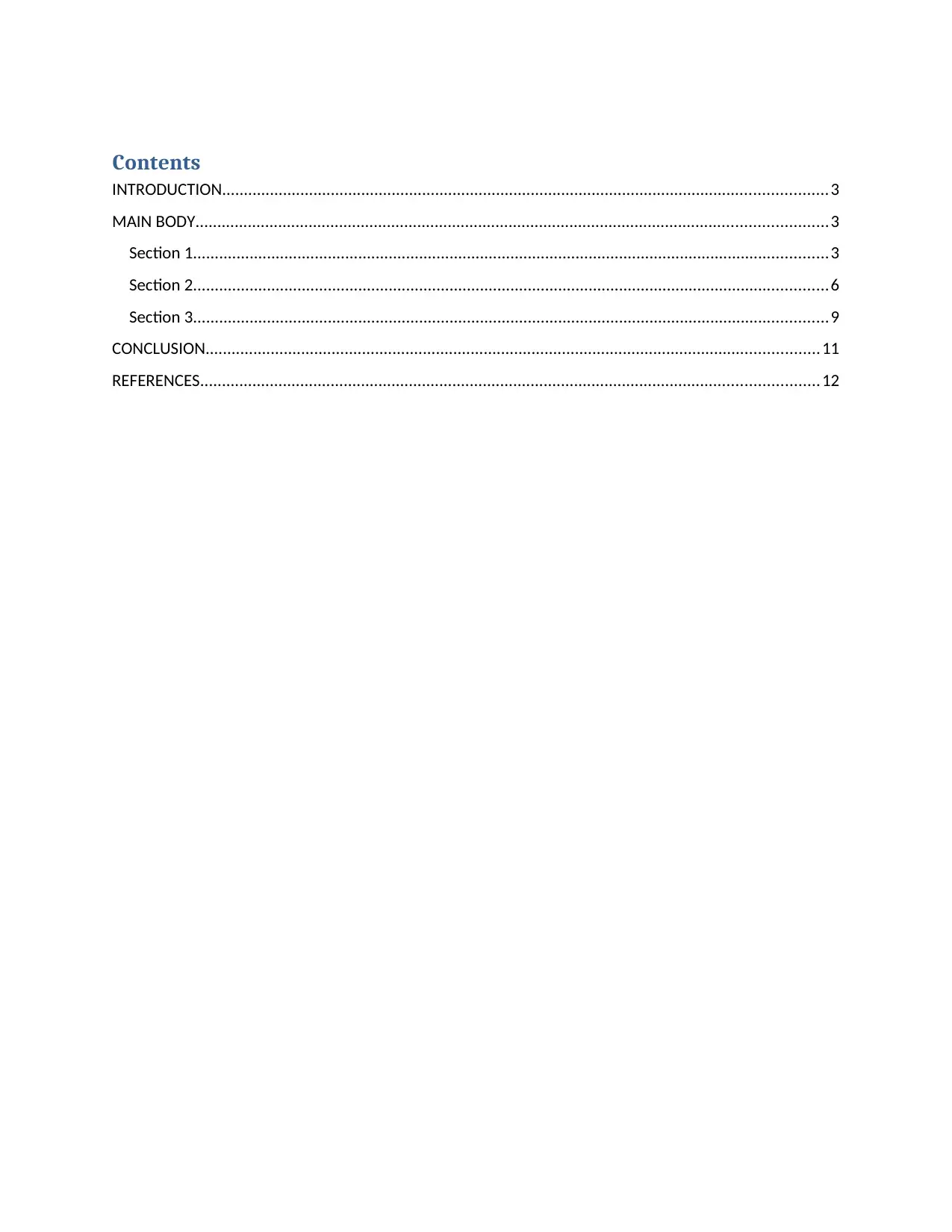
Contents
INTRODUCTION...........................................................................................................................................3
MAIN BODY.................................................................................................................................................3
Section 1..................................................................................................................................................3
Section 2..................................................................................................................................................6
Section 3..................................................................................................................................................9
CONCLUSION.............................................................................................................................................11
REFERENCES..............................................................................................................................................12
INTRODUCTION...........................................................................................................................................3
MAIN BODY.................................................................................................................................................3
Section 1..................................................................................................................................................3
Section 2..................................................................................................................................................6
Section 3..................................................................................................................................................9
CONCLUSION.............................................................................................................................................11
REFERENCES..............................................................................................................................................12
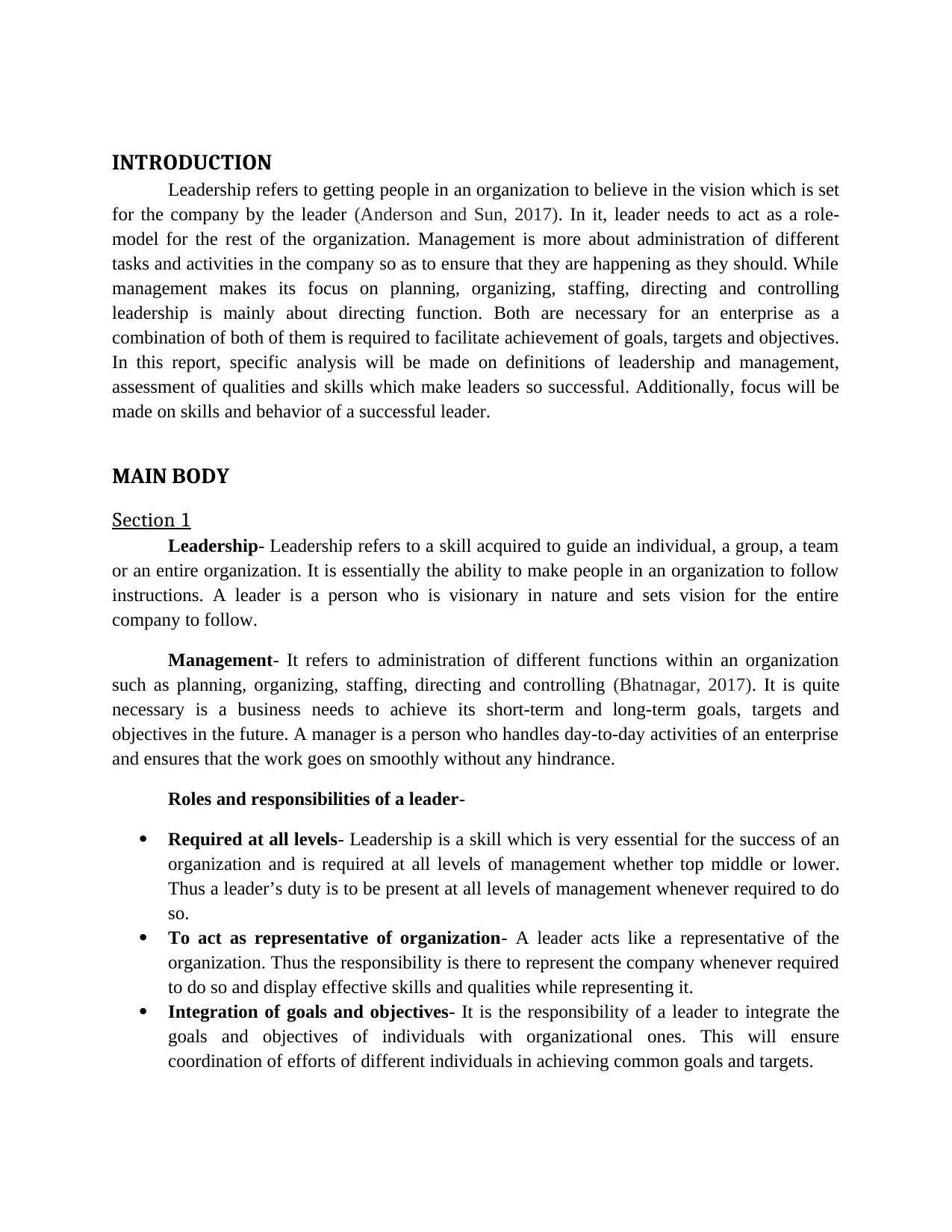
INTRODUCTION
Leadership refers to getting people in an organization to believe in the vision which is set
for the company by the leader (Anderson and Sun, 2017). In it, leader needs to act as a role-
model for the rest of the organization. Management is more about administration of different
tasks and activities in the company so as to ensure that they are happening as they should. While
management makes its focus on planning, organizing, staffing, directing and controlling
leadership is mainly about directing function. Both are necessary for an enterprise as a
combination of both of them is required to facilitate achievement of goals, targets and objectives.
In this report, specific analysis will be made on definitions of leadership and management,
assessment of qualities and skills which make leaders so successful. Additionally, focus will be
made on skills and behavior of a successful leader.
MAIN BODY
Section 1
Leadership- Leadership refers to a skill acquired to guide an individual, a group, a team
or an entire organization. It is essentially the ability to make people in an organization to follow
instructions. A leader is a person who is visionary in nature and sets vision for the entire
company to follow.
Management- It refers to administration of different functions within an organization
such as planning, organizing, staffing, directing and controlling (Bhatnagar, 2017). It is quite
necessary is a business needs to achieve its short-term and long-term goals, targets and
objectives in the future. A manager is a person who handles day-to-day activities of an enterprise
and ensures that the work goes on smoothly without any hindrance.
Roles and responsibilities of a leader-
Required at all levels- Leadership is a skill which is very essential for the success of an
organization and is required at all levels of management whether top middle or lower.
Thus a leader’s duty is to be present at all levels of management whenever required to do
so.
To act as representative of organization- A leader acts like a representative of the
organization. Thus the responsibility is there to represent the company whenever required
to do so and display effective skills and qualities while representing it.
Integration of goals and objectives- It is the responsibility of a leader to integrate the
goals and objectives of individuals with organizational ones. This will ensure
coordination of efforts of different individuals in achieving common goals and targets.
Leadership refers to getting people in an organization to believe in the vision which is set
for the company by the leader (Anderson and Sun, 2017). In it, leader needs to act as a role-
model for the rest of the organization. Management is more about administration of different
tasks and activities in the company so as to ensure that they are happening as they should. While
management makes its focus on planning, organizing, staffing, directing and controlling
leadership is mainly about directing function. Both are necessary for an enterprise as a
combination of both of them is required to facilitate achievement of goals, targets and objectives.
In this report, specific analysis will be made on definitions of leadership and management,
assessment of qualities and skills which make leaders so successful. Additionally, focus will be
made on skills and behavior of a successful leader.
MAIN BODY
Section 1
Leadership- Leadership refers to a skill acquired to guide an individual, a group, a team
or an entire organization. It is essentially the ability to make people in an organization to follow
instructions. A leader is a person who is visionary in nature and sets vision for the entire
company to follow.
Management- It refers to administration of different functions within an organization
such as planning, organizing, staffing, directing and controlling (Bhatnagar, 2017). It is quite
necessary is a business needs to achieve its short-term and long-term goals, targets and
objectives in the future. A manager is a person who handles day-to-day activities of an enterprise
and ensures that the work goes on smoothly without any hindrance.
Roles and responsibilities of a leader-
Required at all levels- Leadership is a skill which is very essential for the success of an
organization and is required at all levels of management whether top middle or lower.
Thus a leader’s duty is to be present at all levels of management whenever required to do
so.
To act as representative of organization- A leader acts like a representative of the
organization. Thus the responsibility is there to represent the company whenever required
to do so and display effective skills and qualities while representing it.
Integration of goals and objectives- It is the responsibility of a leader to integrate the
goals and objectives of individuals with organizational ones. This will ensure
coordination of efforts of different individuals in achieving common goals and targets.
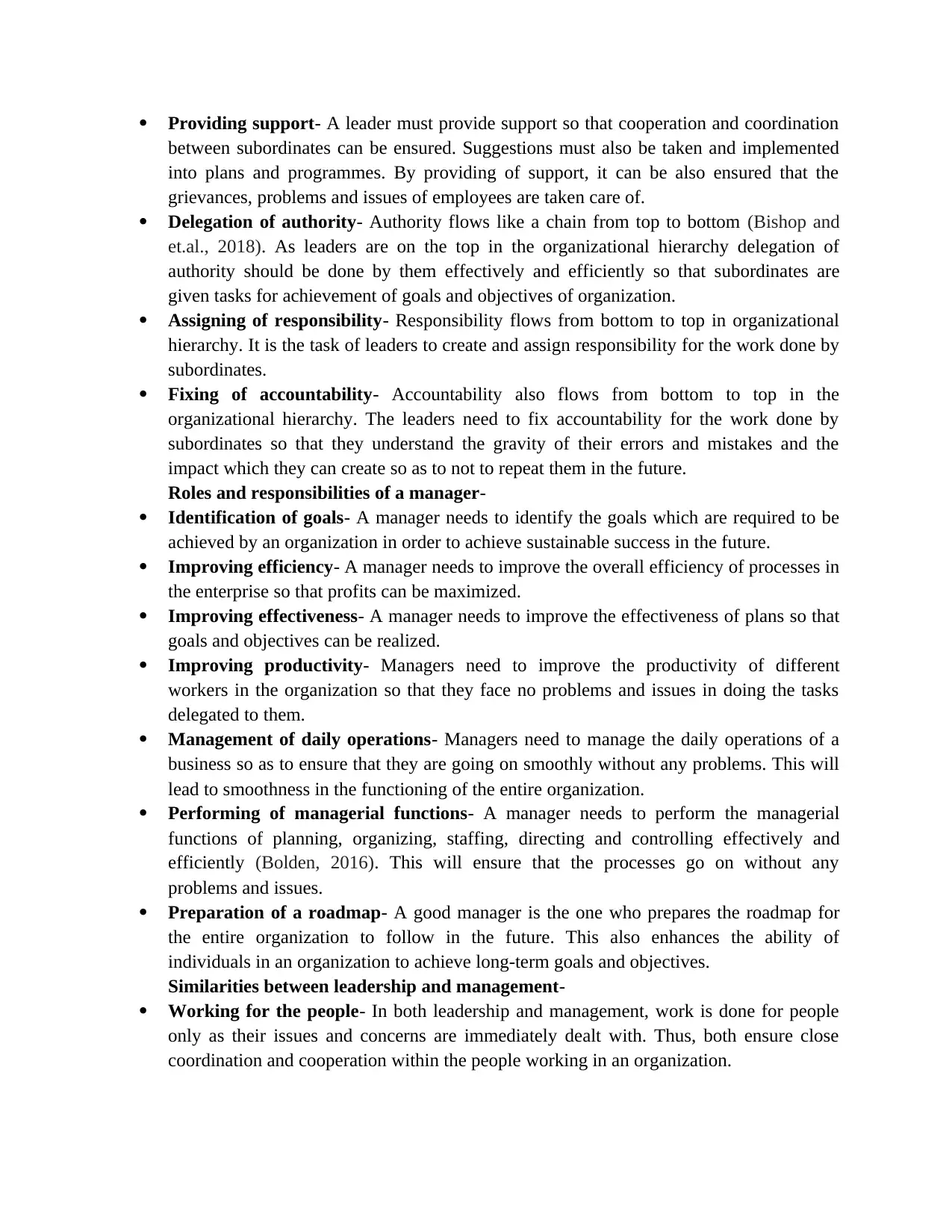
Providing support- A leader must provide support so that cooperation and coordination
between subordinates can be ensured. Suggestions must also be taken and implemented
into plans and programmes. By providing of support, it can be also ensured that the
grievances, problems and issues of employees are taken care of.
Delegation of authority- Authority flows like a chain from top to bottom (Bishop and
et.al., 2018). As leaders are on the top in the organizational hierarchy delegation of
authority should be done by them effectively and efficiently so that subordinates are
given tasks for achievement of goals and objectives of organization.
Assigning of responsibility- Responsibility flows from bottom to top in organizational
hierarchy. It is the task of leaders to create and assign responsibility for the work done by
subordinates.
Fixing of accountability- Accountability also flows from bottom to top in the
organizational hierarchy. The leaders need to fix accountability for the work done by
subordinates so that they understand the gravity of their errors and mistakes and the
impact which they can create so as to not to repeat them in the future.
Roles and responsibilities of a manager-
Identification of goals- A manager needs to identify the goals which are required to be
achieved by an organization in order to achieve sustainable success in the future.
Improving efficiency- A manager needs to improve the overall efficiency of processes in
the enterprise so that profits can be maximized.
Improving effectiveness- A manager needs to improve the effectiveness of plans so that
goals and objectives can be realized.
Improving productivity- Managers need to improve the productivity of different
workers in the organization so that they face no problems and issues in doing the tasks
delegated to them.
Management of daily operations- Managers need to manage the daily operations of a
business so as to ensure that they are going on smoothly without any problems. This will
lead to smoothness in the functioning of the entire organization.
Performing of managerial functions- A manager needs to perform the managerial
functions of planning, organizing, staffing, directing and controlling effectively and
efficiently (Bolden, 2016). This will ensure that the processes go on without any
problems and issues.
Preparation of a roadmap- A good manager is the one who prepares the roadmap for
the entire organization to follow in the future. This also enhances the ability of
individuals in an organization to achieve long-term goals and objectives.
Similarities between leadership and management-
Working for the people- In both leadership and management, work is done for people
only as their issues and concerns are immediately dealt with. Thus, both ensure close
coordination and cooperation within the people working in an organization.
between subordinates can be ensured. Suggestions must also be taken and implemented
into plans and programmes. By providing of support, it can be also ensured that the
grievances, problems and issues of employees are taken care of.
Delegation of authority- Authority flows like a chain from top to bottom (Bishop and
et.al., 2018). As leaders are on the top in the organizational hierarchy delegation of
authority should be done by them effectively and efficiently so that subordinates are
given tasks for achievement of goals and objectives of organization.
Assigning of responsibility- Responsibility flows from bottom to top in organizational
hierarchy. It is the task of leaders to create and assign responsibility for the work done by
subordinates.
Fixing of accountability- Accountability also flows from bottom to top in the
organizational hierarchy. The leaders need to fix accountability for the work done by
subordinates so that they understand the gravity of their errors and mistakes and the
impact which they can create so as to not to repeat them in the future.
Roles and responsibilities of a manager-
Identification of goals- A manager needs to identify the goals which are required to be
achieved by an organization in order to achieve sustainable success in the future.
Improving efficiency- A manager needs to improve the overall efficiency of processes in
the enterprise so that profits can be maximized.
Improving effectiveness- A manager needs to improve the effectiveness of plans so that
goals and objectives can be realized.
Improving productivity- Managers need to improve the productivity of different
workers in the organization so that they face no problems and issues in doing the tasks
delegated to them.
Management of daily operations- Managers need to manage the daily operations of a
business so as to ensure that they are going on smoothly without any problems. This will
lead to smoothness in the functioning of the entire organization.
Performing of managerial functions- A manager needs to perform the managerial
functions of planning, organizing, staffing, directing and controlling effectively and
efficiently (Bolden, 2016). This will ensure that the processes go on without any
problems and issues.
Preparation of a roadmap- A good manager is the one who prepares the roadmap for
the entire organization to follow in the future. This also enhances the ability of
individuals in an organization to achieve long-term goals and objectives.
Similarities between leadership and management-
Working for the people- In both leadership and management, work is done for people
only as their issues and concerns are immediately dealt with. Thus, both ensure close
coordination and cooperation within the people working in an organization.
Secure Best Marks with AI Grader
Need help grading? Try our AI Grader for instant feedback on your assignments.
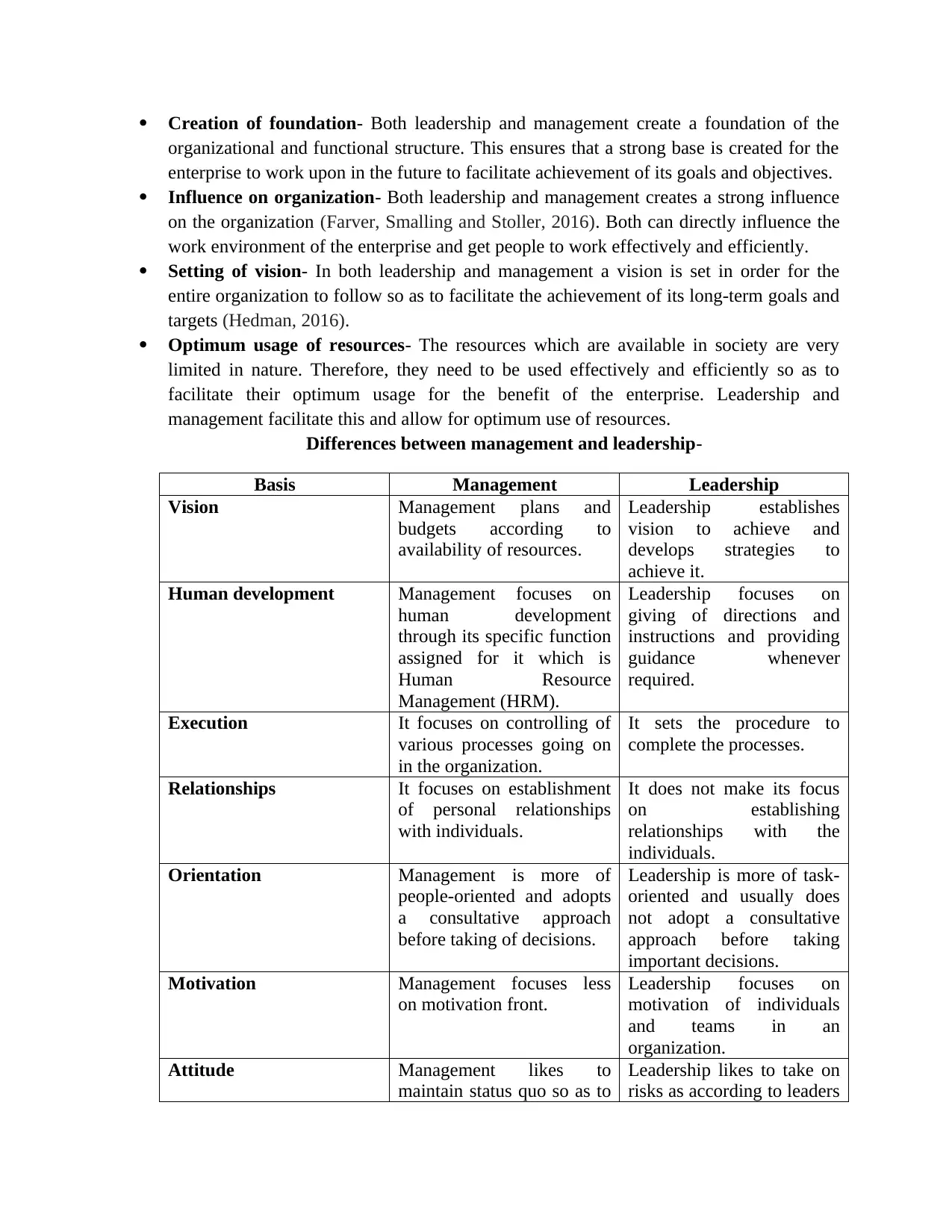
Creation of foundation- Both leadership and management create a foundation of the
organizational and functional structure. This ensures that a strong base is created for the
enterprise to work upon in the future to facilitate achievement of its goals and objectives.
Influence on organization- Both leadership and management creates a strong influence
on the organization (Farver, Smalling and Stoller, 2016). Both can directly influence the
work environment of the enterprise and get people to work effectively and efficiently.
Setting of vision- In both leadership and management a vision is set in order for the
entire organization to follow so as to facilitate the achievement of its long-term goals and
targets (Hedman, 2016).
Optimum usage of resources- The resources which are available in society are very
limited in nature. Therefore, they need to be used effectively and efficiently so as to
facilitate their optimum usage for the benefit of the enterprise. Leadership and
management facilitate this and allow for optimum use of resources.
Differences between management and leadership-
Basis Management Leadership
Vision Management plans and
budgets according to
availability of resources.
Leadership establishes
vision to achieve and
develops strategies to
achieve it.
Human development Management focuses on
human development
through its specific function
assigned for it which is
Human Resource
Management (HRM).
Leadership focuses on
giving of directions and
instructions and providing
guidance whenever
required.
Execution It focuses on controlling of
various processes going on
in the organization.
It sets the procedure to
complete the processes.
Relationships It focuses on establishment
of personal relationships
with individuals.
It does not make its focus
on establishing
relationships with the
individuals.
Orientation Management is more of
people-oriented and adopts
a consultative approach
before taking of decisions.
Leadership is more of task-
oriented and usually does
not adopt a consultative
approach before taking
important decisions.
Motivation Management focuses less
on motivation front.
Leadership focuses on
motivation of individuals
and teams in an
organization.
Attitude Management likes to
maintain status quo so as to
Leadership likes to take on
risks as according to leaders
organizational and functional structure. This ensures that a strong base is created for the
enterprise to work upon in the future to facilitate achievement of its goals and objectives.
Influence on organization- Both leadership and management creates a strong influence
on the organization (Farver, Smalling and Stoller, 2016). Both can directly influence the
work environment of the enterprise and get people to work effectively and efficiently.
Setting of vision- In both leadership and management a vision is set in order for the
entire organization to follow so as to facilitate the achievement of its long-term goals and
targets (Hedman, 2016).
Optimum usage of resources- The resources which are available in society are very
limited in nature. Therefore, they need to be used effectively and efficiently so as to
facilitate their optimum usage for the benefit of the enterprise. Leadership and
management facilitate this and allow for optimum use of resources.
Differences between management and leadership-
Basis Management Leadership
Vision Management plans and
budgets according to
availability of resources.
Leadership establishes
vision to achieve and
develops strategies to
achieve it.
Human development Management focuses on
human development
through its specific function
assigned for it which is
Human Resource
Management (HRM).
Leadership focuses on
giving of directions and
instructions and providing
guidance whenever
required.
Execution It focuses on controlling of
various processes going on
in the organization.
It sets the procedure to
complete the processes.
Relationships It focuses on establishment
of personal relationships
with individuals.
It does not make its focus
on establishing
relationships with the
individuals.
Orientation Management is more of
people-oriented and adopts
a consultative approach
before taking of decisions.
Leadership is more of task-
oriented and usually does
not adopt a consultative
approach before taking
important decisions.
Motivation Management focuses less
on motivation front.
Leadership focuses on
motivation of individuals
and teams in an
organization.
Attitude Management likes to
maintain status quo so as to
Leadership likes to take on
risks as according to leaders
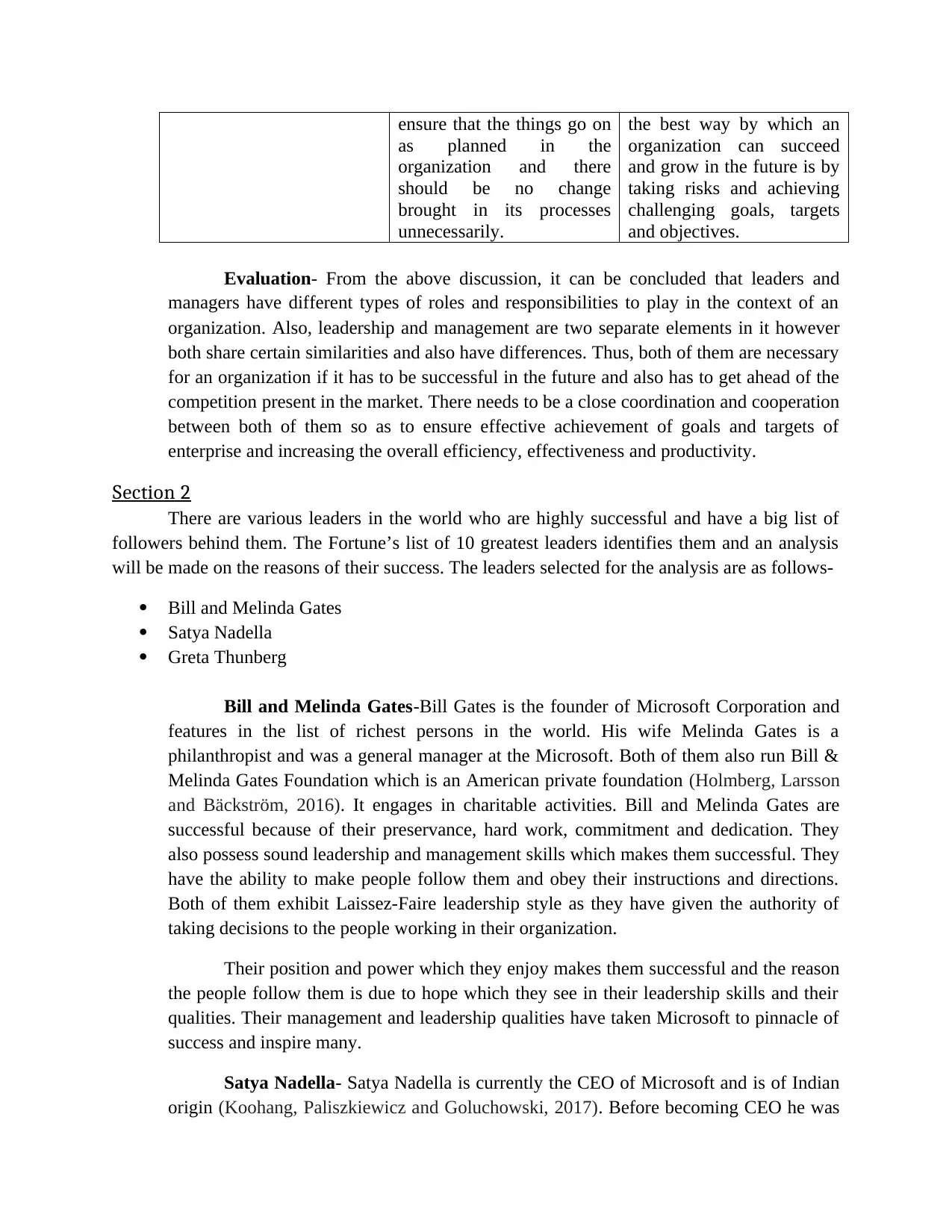
ensure that the things go on
as planned in the
organization and there
should be no change
brought in its processes
unnecessarily.
the best way by which an
organization can succeed
and grow in the future is by
taking risks and achieving
challenging goals, targets
and objectives.
Evaluation- From the above discussion, it can be concluded that leaders and
managers have different types of roles and responsibilities to play in the context of an
organization. Also, leadership and management are two separate elements in it however
both share certain similarities and also have differences. Thus, both of them are necessary
for an organization if it has to be successful in the future and also has to get ahead of the
competition present in the market. There needs to be a close coordination and cooperation
between both of them so as to ensure effective achievement of goals and targets of
enterprise and increasing the overall efficiency, effectiveness and productivity.
Section 2
There are various leaders in the world who are highly successful and have a big list of
followers behind them. The Fortune’s list of 10 greatest leaders identifies them and an analysis
will be made on the reasons of their success. The leaders selected for the analysis are as follows-
Bill and Melinda Gates
Satya Nadella
Greta Thunberg
Bill and Melinda Gates-Bill Gates is the founder of Microsoft Corporation and
features in the list of richest persons in the world. His wife Melinda Gates is a
philanthropist and was a general manager at the Microsoft. Both of them also run Bill &
Melinda Gates Foundation which is an American private foundation (Holmberg, Larsson
and Bäckström, 2016). It engages in charitable activities. Bill and Melinda Gates are
successful because of their preservance, hard work, commitment and dedication. They
also possess sound leadership and management skills which makes them successful. They
have the ability to make people follow them and obey their instructions and directions.
Both of them exhibit Laissez-Faire leadership style as they have given the authority of
taking decisions to the people working in their organization.
Their position and power which they enjoy makes them successful and the reason
the people follow them is due to hope which they see in their leadership skills and their
qualities. Their management and leadership qualities have taken Microsoft to pinnacle of
success and inspire many.
Satya Nadella- Satya Nadella is currently the CEO of Microsoft and is of Indian
origin (Koohang, Paliszkiewicz and Goluchowski, 2017). Before becoming CEO he was
as planned in the
organization and there
should be no change
brought in its processes
unnecessarily.
the best way by which an
organization can succeed
and grow in the future is by
taking risks and achieving
challenging goals, targets
and objectives.
Evaluation- From the above discussion, it can be concluded that leaders and
managers have different types of roles and responsibilities to play in the context of an
organization. Also, leadership and management are two separate elements in it however
both share certain similarities and also have differences. Thus, both of them are necessary
for an organization if it has to be successful in the future and also has to get ahead of the
competition present in the market. There needs to be a close coordination and cooperation
between both of them so as to ensure effective achievement of goals and targets of
enterprise and increasing the overall efficiency, effectiveness and productivity.
Section 2
There are various leaders in the world who are highly successful and have a big list of
followers behind them. The Fortune’s list of 10 greatest leaders identifies them and an analysis
will be made on the reasons of their success. The leaders selected for the analysis are as follows-
Bill and Melinda Gates
Satya Nadella
Greta Thunberg
Bill and Melinda Gates-Bill Gates is the founder of Microsoft Corporation and
features in the list of richest persons in the world. His wife Melinda Gates is a
philanthropist and was a general manager at the Microsoft. Both of them also run Bill &
Melinda Gates Foundation which is an American private foundation (Holmberg, Larsson
and Bäckström, 2016). It engages in charitable activities. Bill and Melinda Gates are
successful because of their preservance, hard work, commitment and dedication. They
also possess sound leadership and management skills which makes them successful. They
have the ability to make people follow them and obey their instructions and directions.
Both of them exhibit Laissez-Faire leadership style as they have given the authority of
taking decisions to the people working in their organization.
Their position and power which they enjoy makes them successful and the reason
the people follow them is due to hope which they see in their leadership skills and their
qualities. Their management and leadership qualities have taken Microsoft to pinnacle of
success and inspire many.
Satya Nadella- Satya Nadella is currently the CEO of Microsoft and is of Indian
origin (Koohang, Paliszkiewicz and Goluchowski, 2017). Before becoming CEO he was
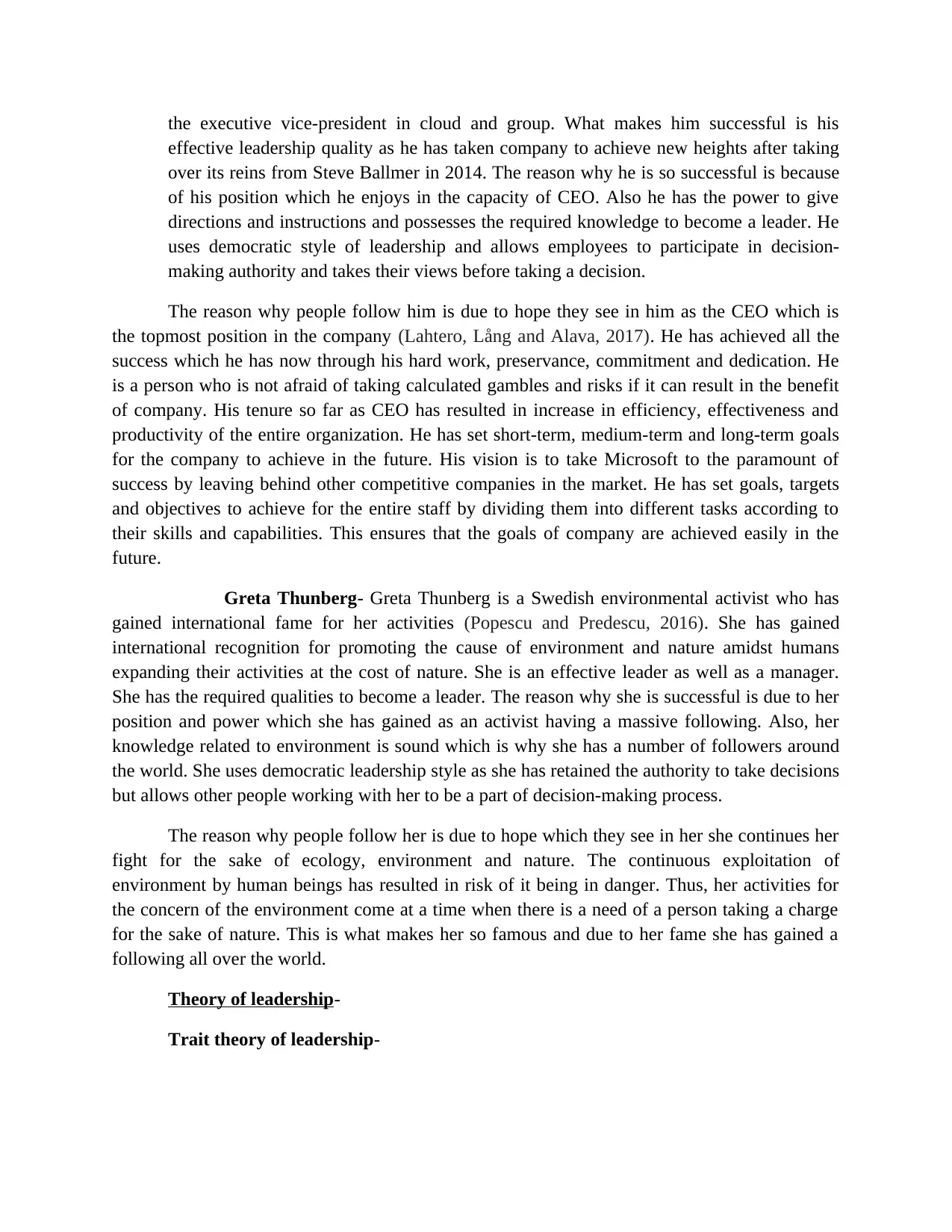
the executive vice-president in cloud and group. What makes him successful is his
effective leadership quality as he has taken company to achieve new heights after taking
over its reins from Steve Ballmer in 2014. The reason why he is so successful is because
of his position which he enjoys in the capacity of CEO. Also he has the power to give
directions and instructions and possesses the required knowledge to become a leader. He
uses democratic style of leadership and allows employees to participate in decision-
making authority and takes their views before taking a decision.
The reason why people follow him is due to hope they see in him as the CEO which is
the topmost position in the company (Lahtero, Lång and Alava, 2017). He has achieved all the
success which he has now through his hard work, preservance, commitment and dedication. He
is a person who is not afraid of taking calculated gambles and risks if it can result in the benefit
of company. His tenure so far as CEO has resulted in increase in efficiency, effectiveness and
productivity of the entire organization. He has set short-term, medium-term and long-term goals
for the company to achieve in the future. His vision is to take Microsoft to the paramount of
success by leaving behind other competitive companies in the market. He has set goals, targets
and objectives to achieve for the entire staff by dividing them into different tasks according to
their skills and capabilities. This ensures that the goals of company are achieved easily in the
future.
Greta Thunberg- Greta Thunberg is a Swedish environmental activist who has
gained international fame for her activities (Popescu and Predescu, 2016). She has gained
international recognition for promoting the cause of environment and nature amidst humans
expanding their activities at the cost of nature. She is an effective leader as well as a manager.
She has the required qualities to become a leader. The reason why she is successful is due to her
position and power which she has gained as an activist having a massive following. Also, her
knowledge related to environment is sound which is why she has a number of followers around
the world. She uses democratic leadership style as she has retained the authority to take decisions
but allows other people working with her to be a part of decision-making process.
The reason why people follow her is due to hope which they see in her she continues her
fight for the sake of ecology, environment and nature. The continuous exploitation of
environment by human beings has resulted in risk of it being in danger. Thus, her activities for
the concern of the environment come at a time when there is a need of a person taking a charge
for the sake of nature. This is what makes her so famous and due to her fame she has gained a
following all over the world.
Theory of leadership-
Trait theory of leadership-
effective leadership quality as he has taken company to achieve new heights after taking
over its reins from Steve Ballmer in 2014. The reason why he is so successful is because
of his position which he enjoys in the capacity of CEO. Also he has the power to give
directions and instructions and possesses the required knowledge to become a leader. He
uses democratic style of leadership and allows employees to participate in decision-
making authority and takes their views before taking a decision.
The reason why people follow him is due to hope they see in him as the CEO which is
the topmost position in the company (Lahtero, Lång and Alava, 2017). He has achieved all the
success which he has now through his hard work, preservance, commitment and dedication. He
is a person who is not afraid of taking calculated gambles and risks if it can result in the benefit
of company. His tenure so far as CEO has resulted in increase in efficiency, effectiveness and
productivity of the entire organization. He has set short-term, medium-term and long-term goals
for the company to achieve in the future. His vision is to take Microsoft to the paramount of
success by leaving behind other competitive companies in the market. He has set goals, targets
and objectives to achieve for the entire staff by dividing them into different tasks according to
their skills and capabilities. This ensures that the goals of company are achieved easily in the
future.
Greta Thunberg- Greta Thunberg is a Swedish environmental activist who has
gained international fame for her activities (Popescu and Predescu, 2016). She has gained
international recognition for promoting the cause of environment and nature amidst humans
expanding their activities at the cost of nature. She is an effective leader as well as a manager.
She has the required qualities to become a leader. The reason why she is successful is due to her
position and power which she has gained as an activist having a massive following. Also, her
knowledge related to environment is sound which is why she has a number of followers around
the world. She uses democratic leadership style as she has retained the authority to take decisions
but allows other people working with her to be a part of decision-making process.
The reason why people follow her is due to hope which they see in her she continues her
fight for the sake of ecology, environment and nature. The continuous exploitation of
environment by human beings has resulted in risk of it being in danger. Thus, her activities for
the concern of the environment come at a time when there is a need of a person taking a charge
for the sake of nature. This is what makes her so famous and due to her fame she has gained a
following all over the world.
Theory of leadership-
Trait theory of leadership-
Paraphrase This Document
Need a fresh take? Get an instant paraphrase of this document with our AI Paraphraser
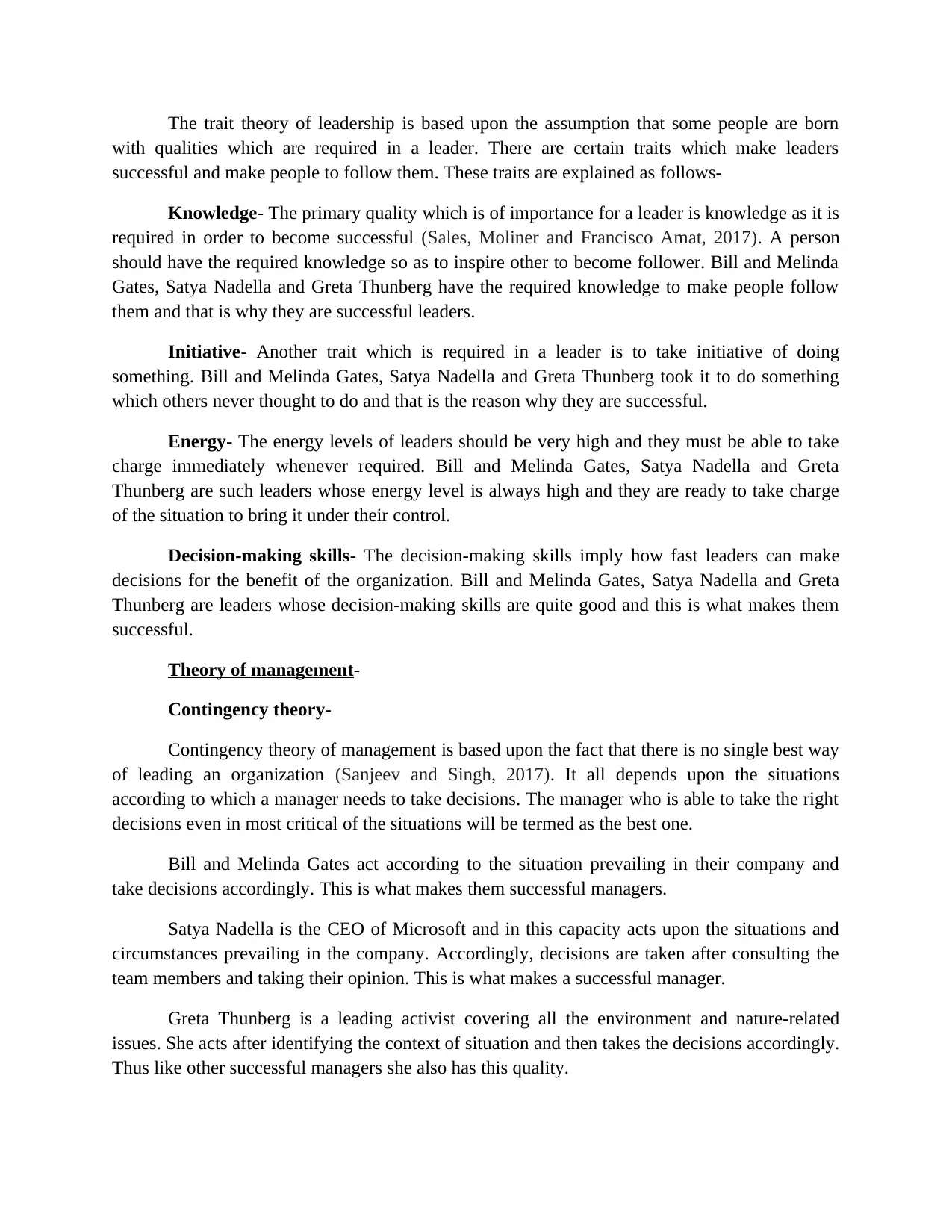
The trait theory of leadership is based upon the assumption that some people are born
with qualities which are required in a leader. There are certain traits which make leaders
successful and make people to follow them. These traits are explained as follows-
Knowledge- The primary quality which is of importance for a leader is knowledge as it is
required in order to become successful (Sales, Moliner and Francisco Amat, 2017). A person
should have the required knowledge so as to inspire other to become follower. Bill and Melinda
Gates, Satya Nadella and Greta Thunberg have the required knowledge to make people follow
them and that is why they are successful leaders.
Initiative- Another trait which is required in a leader is to take initiative of doing
something. Bill and Melinda Gates, Satya Nadella and Greta Thunberg took it to do something
which others never thought to do and that is the reason why they are successful.
Energy- The energy levels of leaders should be very high and they must be able to take
charge immediately whenever required. Bill and Melinda Gates, Satya Nadella and Greta
Thunberg are such leaders whose energy level is always high and they are ready to take charge
of the situation to bring it under their control.
Decision-making skills- The decision-making skills imply how fast leaders can make
decisions for the benefit of the organization. Bill and Melinda Gates, Satya Nadella and Greta
Thunberg are leaders whose decision-making skills are quite good and this is what makes them
successful.
Theory of management-
Contingency theory-
Contingency theory of management is based upon the fact that there is no single best way
of leading an organization (Sanjeev and Singh, 2017). It all depends upon the situations
according to which a manager needs to take decisions. The manager who is able to take the right
decisions even in most critical of the situations will be termed as the best one.
Bill and Melinda Gates act according to the situation prevailing in their company and
take decisions accordingly. This is what makes them successful managers.
Satya Nadella is the CEO of Microsoft and in this capacity acts upon the situations and
circumstances prevailing in the company. Accordingly, decisions are taken after consulting the
team members and taking their opinion. This is what makes a successful manager.
Greta Thunberg is a leading activist covering all the environment and nature-related
issues. She acts after identifying the context of situation and then takes the decisions accordingly.
Thus like other successful managers she also has this quality.
with qualities which are required in a leader. There are certain traits which make leaders
successful and make people to follow them. These traits are explained as follows-
Knowledge- The primary quality which is of importance for a leader is knowledge as it is
required in order to become successful (Sales, Moliner and Francisco Amat, 2017). A person
should have the required knowledge so as to inspire other to become follower. Bill and Melinda
Gates, Satya Nadella and Greta Thunberg have the required knowledge to make people follow
them and that is why they are successful leaders.
Initiative- Another trait which is required in a leader is to take initiative of doing
something. Bill and Melinda Gates, Satya Nadella and Greta Thunberg took it to do something
which others never thought to do and that is the reason why they are successful.
Energy- The energy levels of leaders should be very high and they must be able to take
charge immediately whenever required. Bill and Melinda Gates, Satya Nadella and Greta
Thunberg are such leaders whose energy level is always high and they are ready to take charge
of the situation to bring it under their control.
Decision-making skills- The decision-making skills imply how fast leaders can make
decisions for the benefit of the organization. Bill and Melinda Gates, Satya Nadella and Greta
Thunberg are leaders whose decision-making skills are quite good and this is what makes them
successful.
Theory of management-
Contingency theory-
Contingency theory of management is based upon the fact that there is no single best way
of leading an organization (Sanjeev and Singh, 2017). It all depends upon the situations
according to which a manager needs to take decisions. The manager who is able to take the right
decisions even in most critical of the situations will be termed as the best one.
Bill and Melinda Gates act according to the situation prevailing in their company and
take decisions accordingly. This is what makes them successful managers.
Satya Nadella is the CEO of Microsoft and in this capacity acts upon the situations and
circumstances prevailing in the company. Accordingly, decisions are taken after consulting the
team members and taking their opinion. This is what makes a successful manager.
Greta Thunberg is a leading activist covering all the environment and nature-related
issues. She acts after identifying the context of situation and then takes the decisions accordingly.
Thus like other successful managers she also has this quality.
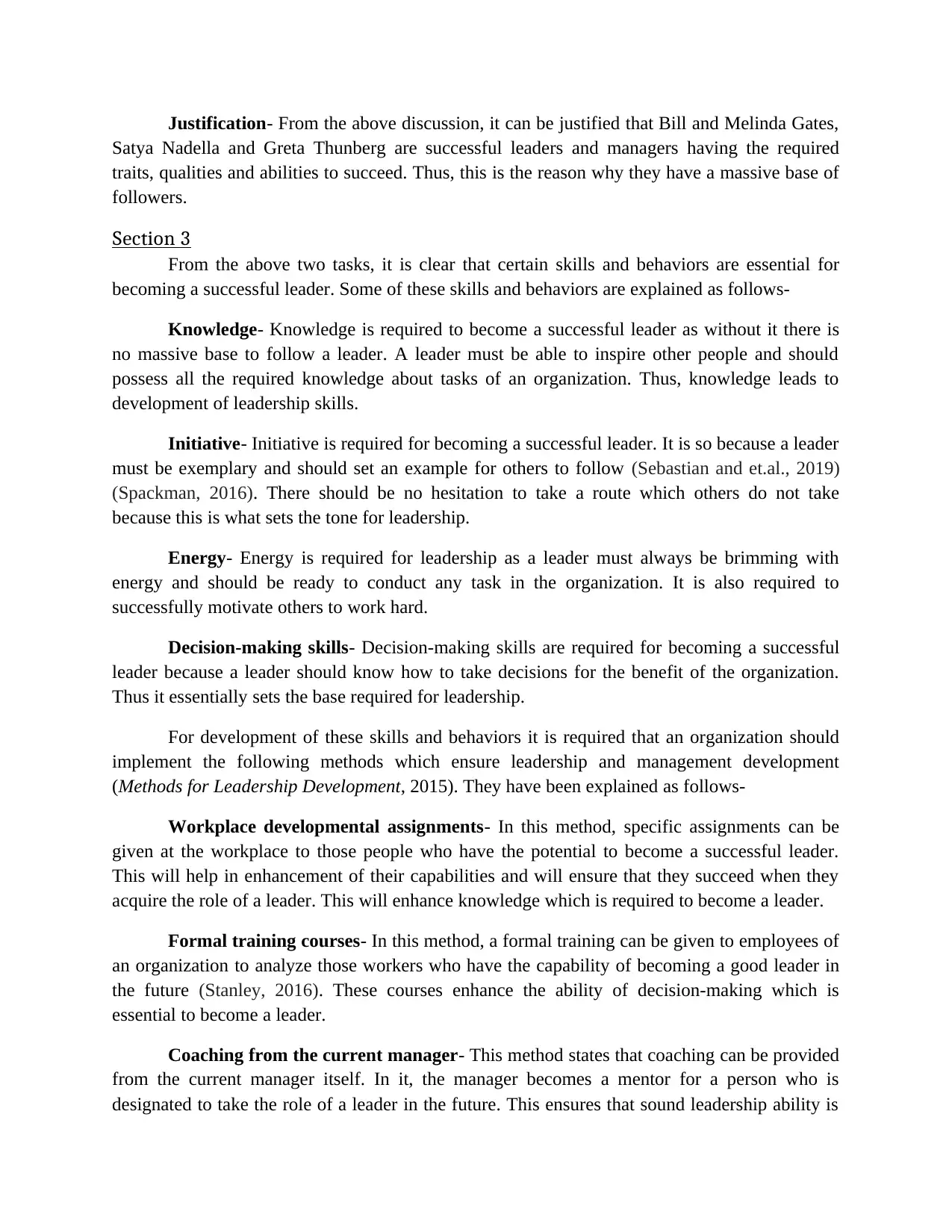
Justification- From the above discussion, it can be justified that Bill and Melinda Gates,
Satya Nadella and Greta Thunberg are successful leaders and managers having the required
traits, qualities and abilities to succeed. Thus, this is the reason why they have a massive base of
followers.
Section 3
From the above two tasks, it is clear that certain skills and behaviors are essential for
becoming a successful leader. Some of these skills and behaviors are explained as follows-
Knowledge- Knowledge is required to become a successful leader as without it there is
no massive base to follow a leader. A leader must be able to inspire other people and should
possess all the required knowledge about tasks of an organization. Thus, knowledge leads to
development of leadership skills.
Initiative- Initiative is required for becoming a successful leader. It is so because a leader
must be exemplary and should set an example for others to follow (Sebastian and et.al., 2019)
(Spackman, 2016). There should be no hesitation to take a route which others do not take
because this is what sets the tone for leadership.
Energy- Energy is required for leadership as a leader must always be brimming with
energy and should be ready to conduct any task in the organization. It is also required to
successfully motivate others to work hard.
Decision-making skills- Decision-making skills are required for becoming a successful
leader because a leader should know how to take decisions for the benefit of the organization.
Thus it essentially sets the base required for leadership.
For development of these skills and behaviors it is required that an organization should
implement the following methods which ensure leadership and management development
(Methods for Leadership Development, 2015). They have been explained as follows-
Workplace developmental assignments- In this method, specific assignments can be
given at the workplace to those people who have the potential to become a successful leader.
This will help in enhancement of their capabilities and will ensure that they succeed when they
acquire the role of a leader. This will enhance knowledge which is required to become a leader.
Formal training courses- In this method, a formal training can be given to employees of
an organization to analyze those workers who have the capability of becoming a good leader in
the future (Stanley, 2016). These courses enhance the ability of decision-making which is
essential to become a leader.
Coaching from the current manager- This method states that coaching can be provided
from the current manager itself. In it, the manager becomes a mentor for a person who is
designated to take the role of a leader in the future. This ensures that sound leadership ability is
Satya Nadella and Greta Thunberg are successful leaders and managers having the required
traits, qualities and abilities to succeed. Thus, this is the reason why they have a massive base of
followers.
Section 3
From the above two tasks, it is clear that certain skills and behaviors are essential for
becoming a successful leader. Some of these skills and behaviors are explained as follows-
Knowledge- Knowledge is required to become a successful leader as without it there is
no massive base to follow a leader. A leader must be able to inspire other people and should
possess all the required knowledge about tasks of an organization. Thus, knowledge leads to
development of leadership skills.
Initiative- Initiative is required for becoming a successful leader. It is so because a leader
must be exemplary and should set an example for others to follow (Sebastian and et.al., 2019)
(Spackman, 2016). There should be no hesitation to take a route which others do not take
because this is what sets the tone for leadership.
Energy- Energy is required for leadership as a leader must always be brimming with
energy and should be ready to conduct any task in the organization. It is also required to
successfully motivate others to work hard.
Decision-making skills- Decision-making skills are required for becoming a successful
leader because a leader should know how to take decisions for the benefit of the organization.
Thus it essentially sets the base required for leadership.
For development of these skills and behaviors it is required that an organization should
implement the following methods which ensure leadership and management development
(Methods for Leadership Development, 2015). They have been explained as follows-
Workplace developmental assignments- In this method, specific assignments can be
given at the workplace to those people who have the potential to become a successful leader.
This will help in enhancement of their capabilities and will ensure that they succeed when they
acquire the role of a leader. This will enhance knowledge which is required to become a leader.
Formal training courses- In this method, a formal training can be given to employees of
an organization to analyze those workers who have the capability of becoming a good leader in
the future (Stanley, 2016). These courses enhance the ability of decision-making which is
essential to become a leader.
Coaching from the current manager- This method states that coaching can be provided
from the current manager itself. In it, the manager becomes a mentor for a person who is
designated to take the role of a leader in the future. This ensures that sound leadership ability is
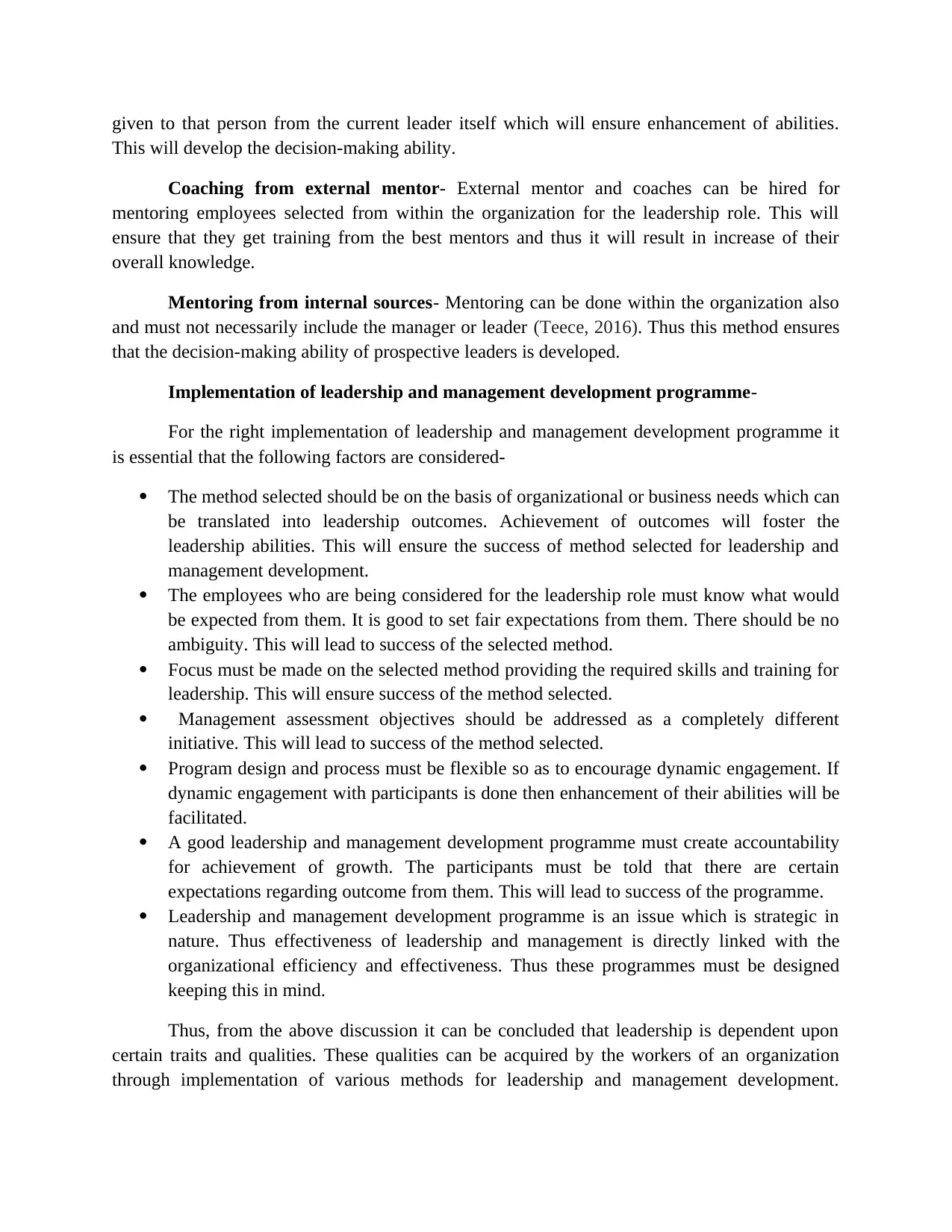
given to that person from the current leader itself which will ensure enhancement of abilities.
This will develop the decision-making ability.
Coaching from external mentor- External mentor and coaches can be hired for
mentoring employees selected from within the organization for the leadership role. This will
ensure that they get training from the best mentors and thus it will result in increase of their
overall knowledge.
Mentoring from internal sources- Mentoring can be done within the organization also
and must not necessarily include the manager or leader (Teece, 2016). Thus this method ensures
that the decision-making ability of prospective leaders is developed.
Implementation of leadership and management development programme-
For the right implementation of leadership and management development programme it
is essential that the following factors are considered-
The method selected should be on the basis of organizational or business needs which can
be translated into leadership outcomes. Achievement of outcomes will foster the
leadership abilities. This will ensure the success of method selected for leadership and
management development.
The employees who are being considered for the leadership role must know what would
be expected from them. It is good to set fair expectations from them. There should be no
ambiguity. This will lead to success of the selected method.
Focus must be made on the selected method providing the required skills and training for
leadership. This will ensure success of the method selected.
Management assessment objectives should be addressed as a completely different
initiative. This will lead to success of the method selected.
Program design and process must be flexible so as to encourage dynamic engagement. If
dynamic engagement with participants is done then enhancement of their abilities will be
facilitated.
A good leadership and management development programme must create accountability
for achievement of growth. The participants must be told that there are certain
expectations regarding outcome from them. This will lead to success of the programme.
Leadership and management development programme is an issue which is strategic in
nature. Thus effectiveness of leadership and management is directly linked with the
organizational efficiency and effectiveness. Thus these programmes must be designed
keeping this in mind.
Thus, from the above discussion it can be concluded that leadership is dependent upon
certain traits and qualities. These qualities can be acquired by the workers of an organization
through implementation of various methods for leadership and management development.
This will develop the decision-making ability.
Coaching from external mentor- External mentor and coaches can be hired for
mentoring employees selected from within the organization for the leadership role. This will
ensure that they get training from the best mentors and thus it will result in increase of their
overall knowledge.
Mentoring from internal sources- Mentoring can be done within the organization also
and must not necessarily include the manager or leader (Teece, 2016). Thus this method ensures
that the decision-making ability of prospective leaders is developed.
Implementation of leadership and management development programme-
For the right implementation of leadership and management development programme it
is essential that the following factors are considered-
The method selected should be on the basis of organizational or business needs which can
be translated into leadership outcomes. Achievement of outcomes will foster the
leadership abilities. This will ensure the success of method selected for leadership and
management development.
The employees who are being considered for the leadership role must know what would
be expected from them. It is good to set fair expectations from them. There should be no
ambiguity. This will lead to success of the selected method.
Focus must be made on the selected method providing the required skills and training for
leadership. This will ensure success of the method selected.
Management assessment objectives should be addressed as a completely different
initiative. This will lead to success of the method selected.
Program design and process must be flexible so as to encourage dynamic engagement. If
dynamic engagement with participants is done then enhancement of their abilities will be
facilitated.
A good leadership and management development programme must create accountability
for achievement of growth. The participants must be told that there are certain
expectations regarding outcome from them. This will lead to success of the programme.
Leadership and management development programme is an issue which is strategic in
nature. Thus effectiveness of leadership and management is directly linked with the
organizational efficiency and effectiveness. Thus these programmes must be designed
keeping this in mind.
Thus, from the above discussion it can be concluded that leadership is dependent upon
certain traits and qualities. These qualities can be acquired by the workers of an organization
through implementation of various methods for leadership and management development.
Secure Best Marks with AI Grader
Need help grading? Try our AI Grader for instant feedback on your assignments.
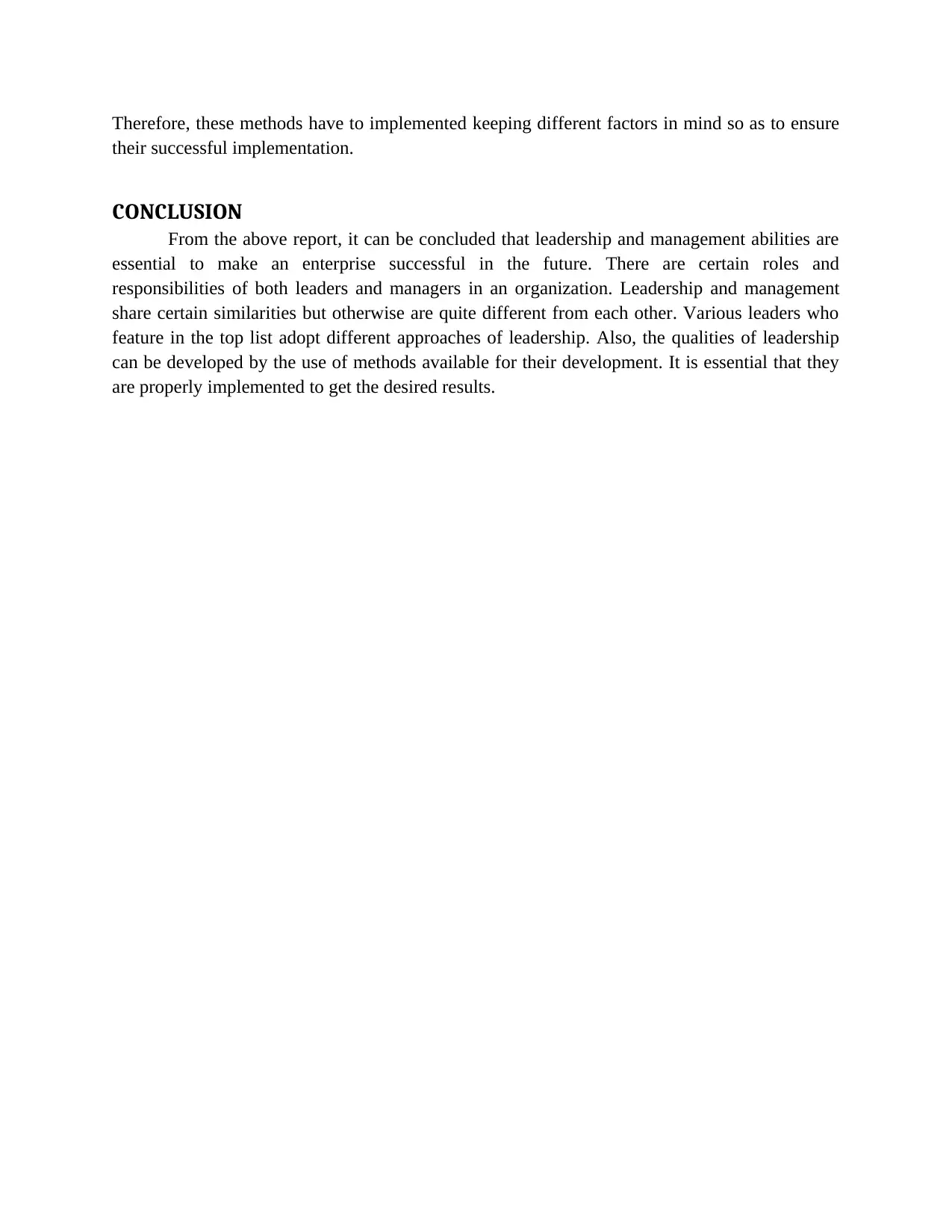
Therefore, these methods have to implemented keeping different factors in mind so as to ensure
their successful implementation.
CONCLUSION
From the above report, it can be concluded that leadership and management abilities are
essential to make an enterprise successful in the future. There are certain roles and
responsibilities of both leaders and managers in an organization. Leadership and management
share certain similarities but otherwise are quite different from each other. Various leaders who
feature in the top list adopt different approaches of leadership. Also, the qualities of leadership
can be developed by the use of methods available for their development. It is essential that they
are properly implemented to get the desired results.
their successful implementation.
CONCLUSION
From the above report, it can be concluded that leadership and management abilities are
essential to make an enterprise successful in the future. There are certain roles and
responsibilities of both leaders and managers in an organization. Leadership and management
share certain similarities but otherwise are quite different from each other. Various leaders who
feature in the top list adopt different approaches of leadership. Also, the qualities of leadership
can be developed by the use of methods available for their development. It is essential that they
are properly implemented to get the desired results.
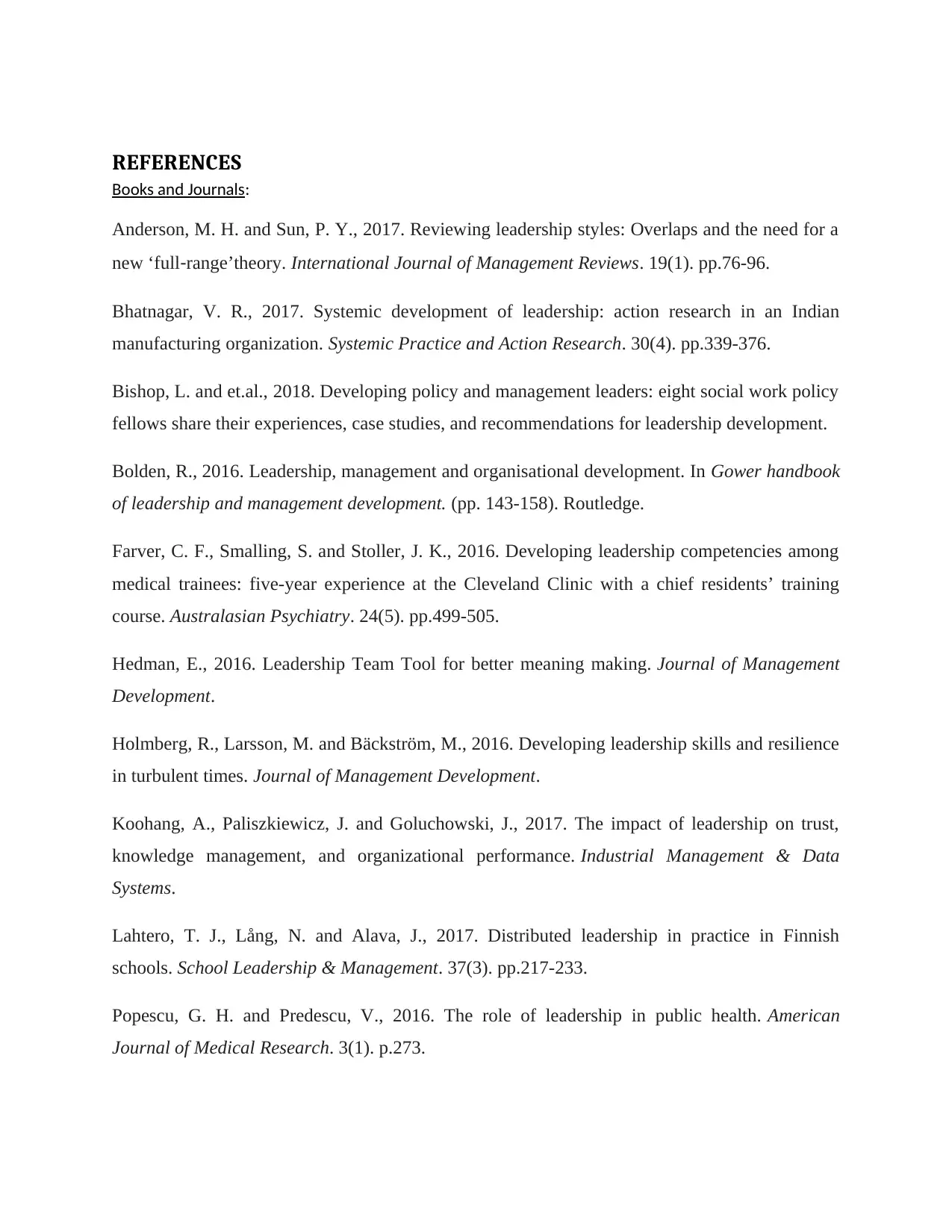
REFERENCES
Books and Journals:
Anderson, M. H. and Sun, P. Y., 2017. Reviewing leadership styles: Overlaps and the need for a
new ‘full‐range’theory. International Journal of Management Reviews. 19(1). pp.76-96.
Bhatnagar, V. R., 2017. Systemic development of leadership: action research in an Indian
manufacturing organization. Systemic Practice and Action Research. 30(4). pp.339-376.
Bishop, L. and et.al., 2018. Developing policy and management leaders: eight social work policy
fellows share their experiences, case studies, and recommendations for leadership development.
Bolden, R., 2016. Leadership, management and organisational development. In Gower handbook
of leadership and management development. (pp. 143-158). Routledge.
Farver, C. F., Smalling, S. and Stoller, J. K., 2016. Developing leadership competencies among
medical trainees: five-year experience at the Cleveland Clinic with a chief residents’ training
course. Australasian Psychiatry. 24(5). pp.499-505.
Hedman, E., 2016. Leadership Team Tool for better meaning making. Journal of Management
Development.
Holmberg, R., Larsson, M. and Bäckström, M., 2016. Developing leadership skills and resilience
in turbulent times. Journal of Management Development.
Koohang, A., Paliszkiewicz, J. and Goluchowski, J., 2017. The impact of leadership on trust,
knowledge management, and organizational performance. Industrial Management & Data
Systems.
Lahtero, T. J., Lång, N. and Alava, J., 2017. Distributed leadership in practice in Finnish
schools. School Leadership & Management. 37(3). pp.217-233.
Popescu, G. H. and Predescu, V., 2016. The role of leadership in public health. American
Journal of Medical Research. 3(1). p.273.
Books and Journals:
Anderson, M. H. and Sun, P. Y., 2017. Reviewing leadership styles: Overlaps and the need for a
new ‘full‐range’theory. International Journal of Management Reviews. 19(1). pp.76-96.
Bhatnagar, V. R., 2017. Systemic development of leadership: action research in an Indian
manufacturing organization. Systemic Practice and Action Research. 30(4). pp.339-376.
Bishop, L. and et.al., 2018. Developing policy and management leaders: eight social work policy
fellows share their experiences, case studies, and recommendations for leadership development.
Bolden, R., 2016. Leadership, management and organisational development. In Gower handbook
of leadership and management development. (pp. 143-158). Routledge.
Farver, C. F., Smalling, S. and Stoller, J. K., 2016. Developing leadership competencies among
medical trainees: five-year experience at the Cleveland Clinic with a chief residents’ training
course. Australasian Psychiatry. 24(5). pp.499-505.
Hedman, E., 2016. Leadership Team Tool for better meaning making. Journal of Management
Development.
Holmberg, R., Larsson, M. and Bäckström, M., 2016. Developing leadership skills and resilience
in turbulent times. Journal of Management Development.
Koohang, A., Paliszkiewicz, J. and Goluchowski, J., 2017. The impact of leadership on trust,
knowledge management, and organizational performance. Industrial Management & Data
Systems.
Lahtero, T. J., Lång, N. and Alava, J., 2017. Distributed leadership in practice in Finnish
schools. School Leadership & Management. 37(3). pp.217-233.
Popescu, G. H. and Predescu, V., 2016. The role of leadership in public health. American
Journal of Medical Research. 3(1). p.273.
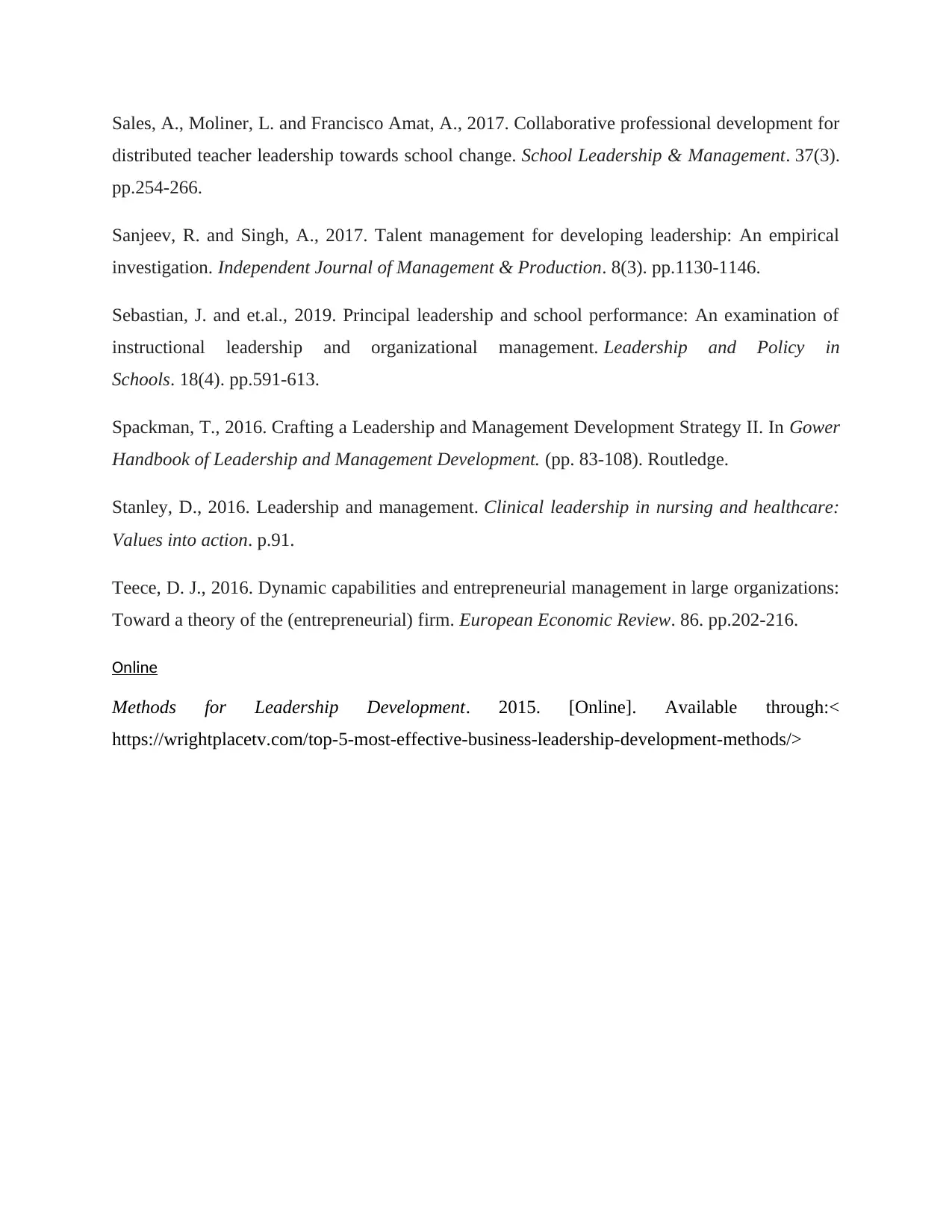
Sales, A., Moliner, L. and Francisco Amat, A., 2017. Collaborative professional development for
distributed teacher leadership towards school change. School Leadership & Management. 37(3).
pp.254-266.
Sanjeev, R. and Singh, A., 2017. Talent management for developing leadership: An empirical
investigation. Independent Journal of Management & Production. 8(3). pp.1130-1146.
Sebastian, J. and et.al., 2019. Principal leadership and school performance: An examination of
instructional leadership and organizational management. Leadership and Policy in
Schools. 18(4). pp.591-613.
Spackman, T., 2016. Crafting a Leadership and Management Development Strategy II. In Gower
Handbook of Leadership and Management Development. (pp. 83-108). Routledge.
Stanley, D., 2016. Leadership and management. Clinical leadership in nursing and healthcare:
Values into action. p.91.
Teece, D. J., 2016. Dynamic capabilities and entrepreneurial management in large organizations:
Toward a theory of the (entrepreneurial) firm. European Economic Review. 86. pp.202-216.
Online
Methods for Leadership Development. 2015. [Online]. Available through:<
https://wrightplacetv.com/top-5-most-effective-business-leadership-development-methods/>
distributed teacher leadership towards school change. School Leadership & Management. 37(3).
pp.254-266.
Sanjeev, R. and Singh, A., 2017. Talent management for developing leadership: An empirical
investigation. Independent Journal of Management & Production. 8(3). pp.1130-1146.
Sebastian, J. and et.al., 2019. Principal leadership and school performance: An examination of
instructional leadership and organizational management. Leadership and Policy in
Schools. 18(4). pp.591-613.
Spackman, T., 2016. Crafting a Leadership and Management Development Strategy II. In Gower
Handbook of Leadership and Management Development. (pp. 83-108). Routledge.
Stanley, D., 2016. Leadership and management. Clinical leadership in nursing and healthcare:
Values into action. p.91.
Teece, D. J., 2016. Dynamic capabilities and entrepreneurial management in large organizations:
Toward a theory of the (entrepreneurial) firm. European Economic Review. 86. pp.202-216.
Online
Methods for Leadership Development. 2015. [Online]. Available through:<
https://wrightplacetv.com/top-5-most-effective-business-leadership-development-methods/>
1 out of 13
Related Documents
Your All-in-One AI-Powered Toolkit for Academic Success.
+13062052269
info@desklib.com
Available 24*7 on WhatsApp / Email
![[object Object]](/_next/static/media/star-bottom.7253800d.svg)
Unlock your academic potential
© 2024 | Zucol Services PVT LTD | All rights reserved.




